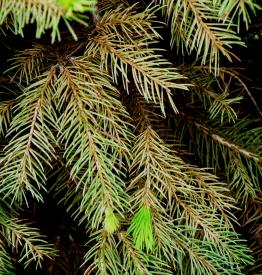

Spruce spider mite damage
|
|
| Severity: | 4 out of 5 |
| Frequency: | 3 out of 5 |
| Symptoms: | Thin silk strands may be found due to mite infestation. Stippling, tiny yellow to whitish spots due to feeding, may cause the needles to die and turn reddish brown when infestations are severe. Heavy infestations frequently cause the loss of entire branches or small trees. |
| Cycle: | Spruce mites, feeding in the spring when temperatures are cool, tend to return in the fall in higher numbers. At first, young mites (larvae) have six legs but after one molt (nymphs) they have eight legs. The adult mites tend to be green, but can be brown. Spruce mites use the wind and their silk strands to disperse. |
| Management: | Reduce stress on trees. Use a sheet of white paper to check for mites starting when saucer magnolia is in pink bud to early bloom. Shake or rap the spruce branch above the paper. If tiny green to brown, slow moving, "dust particles" are seen, a miticide may need to be applied. Spruce mites leave a green streak or blotch when crushed. Some insecticides tend to increase a mite problem by killing off the predatory mites. Insecticidal soap, summer spray oil, and chemical miticides are effective. |
| Associated trees: | |